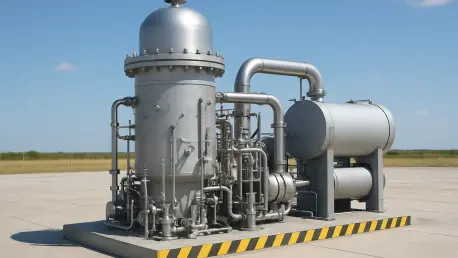Setting the Stage for a Nuclear Revolution
Imagine a future where the soaring energy demands of cutting-edge industries like artificial intelligence and advanced manufacturing are met not by fossil fuels, but by compact, scalable nuclear power plants. This scenario is becoming a tangible possibility with the rise of small modular reactors (SMRs), a technology poised to reshape the U.S. energy landscape. The Tennessee Valley Authority’s (TVA) recent agreement with ENTRA1 Energy to develop up to 6 gigawatts (GW) of SMR capacity marks a pivotal moment, signaling a potential shift in how power is generated and consumed. This market analysis explores the trends, data, and projections surrounding SMRs, assessing their viability as a cornerstone of America’s energy future. By delving into current patterns and future possibilities, the goal is to uncover whether this innovative approach can meet both economic and environmental imperatives in a rapidly evolving sector.
Diving Deep into Market Trends and Projections
SMR Technology: Redefining Nuclear Energy Dynamics
The nuclear energy market has long been constrained by the high costs and extended timelines associated with traditional reactors, but SMRs are introducing a fresh paradigm. These compact units, exemplified by NuScale Power’s designs recently approved by the Nuclear Regulatory Commission (NRC), offer a smaller footprint and modular construction that promise reduced expenses and faster deployment. With approvals for a 77-MW module and a 462-MW plant design solidified, the technological foundation for SMRs appears robust. The market implication is clear: utilities seeking reliable, low-carbon baseload power now have a more flexible option, potentially disrupting the dominance of fossil fuel-based solutions in regions with high energy needs.
Moreover, the scalability of SMRs aligns with the growing demand for customized energy solutions. Unlike conventional nuclear plants that require decades to build, these reactors can be assembled in factories and deployed incrementally, allowing utilities to match capacity with demand growth. TVA’s plan to harness 6 GW—sufficient to power 4.5 million homes or 60 data centers—underscores the scale at which SMRs could penetrate the market. However, while the technology shows promise, its untested nature at such magnitudes raises questions about real-world efficiency and whether cost savings will hold under broader implementation.
Economic Forces and Surging Energy Demand
Energy demand in the U.S., particularly in TVA’s seven-state territory, is accelerating at triple the national average, driven by high-tech sectors like AI and quantum computing. This trend is pushing utilities to explore alternatives to renewables, which, despite their growth, struggle to provide consistent baseload power. SMRs enter the market as a compelling solution, offering steady electricity generation with a smaller carbon footprint than coal or natural gas. Yet, the economic barriers remain significant—upfront costs, even if lower than traditional nuclear, could deter widespread adoption without substantial public or private investment.
The public-private partnership model, as seen in TVA’s collaboration with ENTRA1 Energy, presents a potential way to mitigate financial risks. Under this arrangement, ENTRA1 will own and develop the SMR plants while selling power to TVA, spreading the economic burden across stakeholders. With TVA already committing $19 billion to infrastructure upgrades, including 3,570 MW of generation under construction as of this year, the integration of SMRs into this investment strategy could redefine cost structures in the nuclear sector. Still, undisclosed financial terms in the memorandum of understanding leave analysts cautious about long-term affordability and market competitiveness against cheaper renewables.
Regulatory Environment and Regional Market Nuances
Navigating the regulatory landscape remains a critical factor in the SMR market’s trajectory. While NRC approvals provide a green light for NuScale’s designs, each prospective site will face environmental reviews and community scrutiny, processes that could delay projects by years. TVA’s proactive approach—exploring potential locations with federal agencies and considering gas-fired capabilities for flexibility—demonstrates an awareness of these challenges. However, regional variations in energy needs and public perception of nuclear power, often influenced by historical safety concerns, could create uneven market acceptance across different states.
The market impact of these regulatory hurdles is twofold: they slow the pace of SMR deployment, potentially ceding ground to faster-moving renewable projects, and they increase the importance of transparent communication to build public trust. Industry observers note that addressing safety myths through education on SMRs’ advanced passive cooling systems could bolster market confidence. If successful, such efforts might pave the way for a broader national rollout, transforming SMRs from a regional experiment into a mainstream energy solution over the next decade, from now through 2035.
Future Outlook: SMRs in the Energy Mix
Looking ahead, the integration of SMRs into America’s energy portfolio hinges on several evolving trends. Innovations in reactor design and manufacturing are expected to drive down costs further, making nuclear power more competitive with solar and wind in certain markets. Additionally, regulatory streamlining could accelerate project timelines, enabling utilities to respond more swiftly to demand spikes. TVA’s ambitious 6 GW program, if realized, might serve as a catalyst, encouraging other utilities to adopt similar initiatives and potentially doubling the nuclear market share in high-demand regions by 2030.
Another key projection centers on the decarbonization push, with SMRs positioned as a vital tool for reducing reliance on fossil fuels. Market analysts anticipate that successful pilot projects could unlock billions in federal and private funding, especially if aligned with incentives for clean energy. However, economic uncertainties and shifting policy priorities—such as subsidies for renewables—might limit SMRs to a niche role unless cost parity is achieved. The balance between innovation and pragmatism will ultimately shape whether this technology becomes a dominant force or a supplementary player in the energy market.
Reflecting on Market Insights and Strategic Pathways
Looking back, the analysis of small modular reactors revealed a technology brimming with potential to address America’s escalating energy demands while aligning with sustainability goals. The TVA-ENTRA1 partnership stood as a landmark effort, highlighting the scalability and promise of SMRs against a backdrop of regulatory and economic challenges. For stakeholders, the path forward involves prioritizing pilot projects to test integration and efficiency, advocating for policies that support public-private collaborations, and investing in community engagement to dispel safety concerns. Utilities and businesses could explore feasibility studies with local partners to assess site-specific opportunities, while policymakers might consider targeted incentives to accelerate deployment. By focusing on these actionable steps, the energy sector could transform the theoretical advantages of SMRs into concrete market outcomes, ensuring a resilient power grid for the years ahead.









